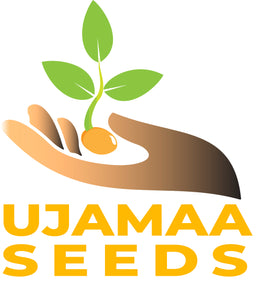Monticello White Sesame
Sesamum indicum
Seeds per pack approx. 125
Germination: 90% Jul 2024 Packed for 2025
Origins and History
Monticello White Sesame is an heirloom variety with deep historical roots tied to early American agriculture. Introduced to the United States from Africa through the transatlantic slave trade, sesame—often referred to as benne—was cultivated in the gardens of enslaved Africans for its oil-rich seeds. Thomas Jefferson grew this particular white sesame at Monticello, recognizing its adaptability to Virginia’s soils and its value as an oilseed crop. The name “Monticello White” honors its preservation in Jefferson’s experimental plots and represents one of the earliest sesame varieties documented in American history.
Appearance and Characteristics
This heirloom produces upright plants typically 3–6 feet tall, with tubular, bell-shaped white flowers that attract pollinators. The seed pods mature to a light tan, containing small, ivory-white seeds known for their high oil content and delicate flavor. The plants are drought-tolerant, making them suitable for warm and dry conditions, and their tall stalks give them an ornamental presence in the garden.
Culinary Uses
Monticello White Sesame seeds are prized for their nutty, sweet flavor and versatility. The seeds can be toasted and sprinkled on breads, pastries, and rice dishes, or pressed to yield sesame oil, a cornerstone in both African and Asian cuisines. In the South, benne seeds have historical ties to Gullah Geechee cooking, where they are used in benne cakes and savory dishes. This heirloom thus carries not only culinary richness but also cultural legacy.
Growing Tips
Sesame thrives in warm climates and is best suited for USDA Zones 7–10. It requires full sun and well-drained soil with moderate fertility. Seeds should be sown directly into the ground after the last frost, when soil temperatures reach at least 70°F. Sow at a depth of ¼ inch, spacing plants 6–12 inches apart in rows 18–24 inches apart. Once established, sesame is highly drought-resistant and requires minimal watering, making it a resilient crop for summer gardens.
Harvesting Guidance
Sesame is ready to harvest when the seed pods begin to dry and turn light brown, but before they split open. Cut the stalks and allow them to cure upside down in a dry, well-ventilated place to prevent seed loss. Once fully dry, the pods can be threshed to release the small, white seeds. Proper drying and storage in airtight containers ensure the seeds retain their flavor and viability for culinary use or future planting.
Botanical Origins of Sesamun indicum
Sesamum indicum, commonly known as sesame, is one of the world’s oldest oilseed crops, belonging to the family Pedaliaceae. Its wild relatives are distributed primarily in sub-Saharan Africa and parts of the Indian subcontinent. The most probable center of origin is thought to be Africa, where several wild Sesamum species still grow, particularly in Ethiopia. However, genetic and archaeological evidence also points to an early secondary center of domestication in the Indian subcontinent, where the species has been cultivated for millennia. The crop’s drought tolerance and adaptability to marginal soils contributed to its early success as a dependable source of edible oil.
History of Domestication
Domestication of Sesamum indicum likely occurred over 3,000 years ago. Archaeological remains from the Indus Valley Civilization (around 2500–2000 BCE) suggest sesame was already under cultivation in ancient India, where it may have been domesticated from the wild species S. mulayanum. In ancient Mesopotamia, sesame oil was valued both for cooking and for ritual uses, indicating its early trade and cultural significance. The plant’s small seeds, high oil content (up to 60%), and relatively easy extraction process made it a vital early oilseed crop. Selective cultivation favored non-shattering seed pods, increased seed size, and improved oil quality.
Spread and Diversification
From its centers of domestication, sesame spread widely through early trade routes. It reached China by at least 2000 BCE, where it was used in traditional medicine and culinary preparations. Ancient Egyptian records also reference sesame as a food and medicinal oil, and the Greeks and Romans later adopted it into their diets. Over centuries, Sesamum indicum diversified into numerous landraces and varieties adapted to local climates—ranging from black and brown to white-seeded forms—each associated with distinct cultural and culinary uses. Today, sesame is cultivated in more than 70 countries, with major production centers in India, China, Sudan, Myanmar, and Nigeria. Its genetic diversity reflects centuries of human selection for flavor, seed color, oil content, and adaptability, making it both an ancient and continually evolving crop of global significance.





